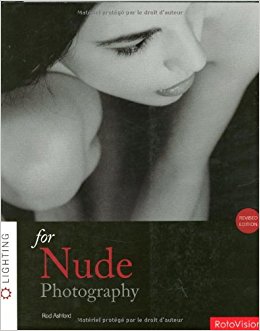Straightforward Nude Photography
writer: russell j.t. dyer; posted: sep 2009; revised: oct 2017; readers past month: 673
Review of Lighting for Nude Photography

author: Rod Ashford
edition: 2
published: 2008
publisher: RotoVision SA
isbn: 978-2-94037-831-9
pages: 160
Buy on Amazon
Many people are shy about being photographed. One reason for this is because they can’t distract the camera and thereby the later viewer of the photograph from seeing their short-comings, aspects of themselves of which they’re self-concious. Certainly many of these problems can be dealt with in Adobe Photoshop. However, it’s better if the original photograph is well done. The better the shot, the better the final print will be. This means proper composition, posing, focusing, exposure settings and good lighting.
In a studio, the photographer has much more control over lighting. However, bad arrangement of lighting can lead to terrible skin coloring, dark circles under the eyes, wrinkles and blemishes where there are none, and many other unflattering effects. Proper lighting can also smooth over what the camera sees and distract the viewer from aspects about which the model is concerned. All of this, though, is even greater when photographing a nude model. The more skin and less clothes to hide the body, the greater the chance for disappointing and perhaps hurtful results.
There are many books on photographing nudes. However, I’ve found that most of them seem to play more on the sexual interests of readers (primarily male readers, in my female chauvinistic opinion) who are excited about looking at nude photos and the idea of maybe photographing nude women, than providing useful instructions on the subject. They tell the reader very little about taking nude photos and just present well taken photos of nude women. The result is that I’ve learned very little about the subject from these books, which usually aren’t very cheap either.
In Rod Ashford’s book Lighting for Nude Photography, published by RotoVision, he presents some very practical information on taking good photos. Contrary to my complaints about other books, though, and irronically, he provides very little tutorial text on photographing nudes and still has created the best book on the subject I’ve found so far. In a subtle way, it does the job that an experienced, terse photographer might do if he were to help you learn how to photograph nudes: he would just say, “Put your camera here and point it there. Now put one light there with this reflector and another over there. Now, call the model over and have her sit there and face that way. Snap the picture and see what you get.” Really, that’s all you need, but repeated many times.
Content Highlights
This book isn’t exactly organized in chapters. Instead, there are a few pages of introduction and some basics of lighting and then the rest of the book is a handbook for many popular nude poses and hot to set up the lighting for them. Still, let me highlight each section so you have a better understanding of the book’s contents.
In the first background pages of the book, he touches on some things the reader should already know about lighting, but with his own take on them. If after reading through these pages — which I recommend — you find that you don’t understand what he’s saying, you may want to consider getting a more basic studio photography book before making someone take their clothes off for you. It could be embarrassing for you and irritating for the model. After this, Ashford highlights light meters and their value for a couple of pages. Next he provides some thoughts being in control of light: reflecting, defusing, filing, and mixing. He also touches on the idea of using sun light, flashes, and strobe lights. He ends this background section with a run down of terms he uses throughout the book and a legend of lighting icons used in the book to illustrate which lights are place where in relation to the model and camera.
The remainder of the book provides a practical guide of how to photograph a nude model. For each project (for lack of a better word), you’re shown the final photograph taken: usually a full page shot. Then you’re given another full page showing an artist’s drawing of where the model and relavent items are place (e.g., a chair or a bed), where each light source is placed — including any windows, and where the camera is positioned. This includes the angle and height of each — not in actual degrees or feet, though, but in general. The layout page includes notes and tips on putting the shot together. That’s it. It’s as simple as that. Basically, flip through the book — perhaps with the model in advance — and look for a shot or pose that you and the model like. If you have the necessary elements (i.e., the necessary lighting equipment), set up your studio or room and try to take the shot. Make adjustments for your particular studio and equipment, as well as to suit the model.
Conclusion
If you’ve never photographed nude models, but have experience in studio lighting, you can use this book to help you get practice taking nude photos. Just find a patient and willing model and then take you time setting up and taking a couple shots from the book each time. Over many sessions, you’ll naturally improve your skills and style. Just be patient with yourself.